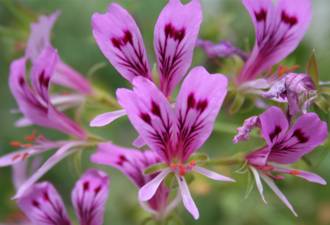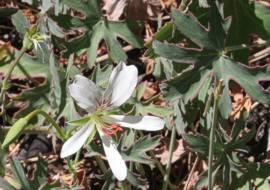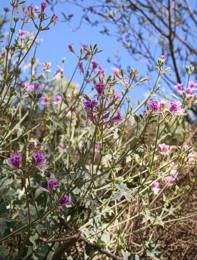Pelargonium grandiflorum
Pelargonium grandiflorum (Andr.) Willd.
Family: Geraniaceae
Common names: Large flowered pelargonium
Introduction
One cannot but stop and admire the beautiful large flowers of this pelargonium.

Description
Description
Pelargonium grandiflorum is an erect straggling herbaceous shrub, usually growing to a height of 0.75 m. The glaucous stem is soft smooth and shiny. The foliage is attractive, smooth and glaucous.

The dull grayish green leaves are deeply palmately lobed, usually 5 cm long and 8 cm wide. The leaf margins are coarsely toothed and some of the leaves have a brownish zonal marking. The fairly large and beautiful flowers vary from creamish-white to pink with darker blotches on the upper two petals. Pelargonium grandiflorum flowers from August to January.
Conservation Status
Status
Pelargonium grandiflorum is listed on the Red List of South African plants (Raimondo et al. 2009) as Least Concern. A taxon is Least Concern when it has been evaluated against the five IUCN criteria and does not qualify for the categories Critically Endangered, Endangered, Vulnerable or Near Threatened.
Distribution and habitat
Distribution description
Pelargonium grandiflorum is restricted to the south western and western Cape areas where it occurs from Nieuwoudtville to Tulbagh. It grows in mountainous habitats, usually on rocky sandstone slopes at an altitude of around 300 metres.
Derivation of name and historical aspects
History

Pelargonium grandiflorum belongs in the family Geraniaceae, a large cosmopolitan family of approximately 11 genera and 800 species in subtropical and temperate regions of the world. The South African genera in the Geraniaceae family are Monsonia, Sarcocaulon, Pelargonium, Erodium and Geranium. There are approximately 270 species of Pelargonium which occur in S, E and NE Africa, Asia, St Helena, Tristan da Cunha, Madagascar, Australia and New Zealand, most of which (± 219 species) occur in southern Africa. Pelargoniums are often wrongly called geraniums. Pelargonium gets its name from the resemblance of the shape of the fruit to the beak of a stork, which is pelargos in Greek. The species epithet, grandi (Latin), referring to large and florum (Latin) refers to flower. Hence the common name large flowered pelargonium. Kew Garden's first plant hunter Francis Masson, a Scottish botanist and gardener, introduced the species into England in 1794.
Ecology
Ecology
The seed is adapted to wind dispersal. Once they reach the ground they bore their way into the soil. This is possible due to the corkscrew tail attached to the end of the seed. As the wind blows, so the corkscrew turns, much like a drill bit.
Uses
Use
Pelargonium grandiflorum will be horticulturally rewarding in your garden. Pelargoniums are a versatile group of plants and are easily adaptable to any garden situation. Before planting in the garden add plenty of compost to the soil. Position the plants in your garden bed in groups of three or five. Plant this pelargonium as part of a shrubby border or in a large rockery or even around your small pond. You could use it to line pathways or as an edging along the front of your flower bed that contains taller shrubs. Light pruning after flowering will neaten the bush.

Growing Pelargonium grandiflorum
Grow
Pelargonium grandiflorum can be propagated from seed and cuttings. Stem cuttings, 15 cm long selected from healthy vigorous plants can be taken at any time of the year. This is also the most commonly used method of propagating pelargoniums. Plants grown through this method will flower within 3 to 6 months. A rooting hormone will accelerate and improve rooting success. Place the cuttings in a propagation tray, containing separate compartments or plugs with river sand and place in cold frames or well lit area and keep them moist, not saturated. The cuttings should root in 3 weeks. Give the rooted cuttings a 3 week weaning period and transplant them into a well-drained potting soil mix and place them in a shady position.
Sow seeds in late summer to early autumn. The seed should be sown in a light, well-drained soil mix. Sprinkle the seeds evenly in the seed tray and cover them with fine white silica sand or fine-milled pine bark. The seeds should be watered gently but thoroughly with a fine soft nozzle spray head or watering can. Place the sown seed in light shade with no direct sun. The seeds germinate in 3 weeks. Transplant into smaller half litre bags or 5cm pots when the seedlings have 3 pairs of leaves. Plants grown from seeds will flower within 12 to 18 months. Pelargoniums grow happily outdoors free of diseases, but if the same plant is grown indoors or in a greenhouse the warmer conditions and lack of air circulation usually result in pests such as aphids, white fly and mealy bug. They can also be susceptible to fungal diseases such as rust and powdery mildew. Please contact your local garden centre to ask for the appropriate pesticide and fungicide to treat these problems.
References
- Goldblatt, P. & Manning, J. 1997. Nieuwoudtville Bokkeveld Plateau & Hantam. South African Wild Flower Guide 9. Botanical Society of South Africa. Claremont.
- Goldblatt, P. & Manning, J. 2000. Cape plants. A conspectus of the Cape flora of South Africa. Strelitzia 9. National Botanical Institute, Pretoria & Missouri Botanical Garden Press, Missouri.
- Raimondo, D., Von Staden, L., Foden, W., Victor, J.E., Helme, N.A., Turner, R.C., Kamundi, D.A. & Manyama, P.A. (eds) 2009. Red List of South African plants. Strelitzia 25. South African National Biodiversity Institute, Pretoria.
- Van der Walt, J.J. 1977. Pelargoniums of southern Africa. Purnell, Cape Town.
Credits
Trevor Adams
Kirstenbosch National Botanical Garden
March 2011
Plant Attributes:
Plant Type: Shrub
SA Distribution: Western Cape
Soil type: Sandy
Flowering season: Early Summer, Late Summer
PH: Acid
Flower colour: Purple, Mauve/Lilac
Aspect: Full Sun
Gardening skill: Average
Special Features:
Horticultural zones










Rate this article
Article well written and informative
Rate this plant
Is this an interesting plant?
Login to add your Comment
Back to topNot registered yet? Click here to register.